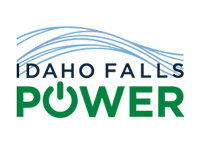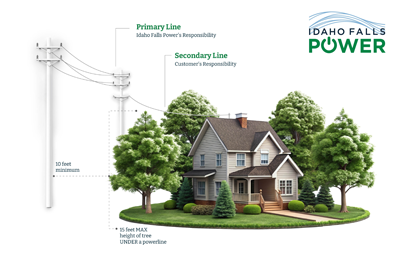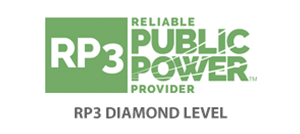Vegetation Management
Enhancing Urban Landscapes and Public Safety
Our goal is to ensure safe and reliable electricity for all Idaho Falls residents. Therefore, Idaho Falls Power has implemented a comprehensive vegetation management program. This initiative helps maintain safe clearance between trees, shrubs, and power lines through techniques like tree removal and selective trimming. This booklet offers helpful guidelines on choosing, planting, and caring for trees— supporting a future where today's plantings enhance both the beauty and safety of our community.

Benefits of Trees in Urban Areas
Trees provide numerous advantages for both the environment and our daily lives. They help lower sidewalk temperatures in summer, serve as windbreakers and privacy screens, reduce home cooling costs, and offer food and shelter for wildlife. In addition, trees improve air quality and increase property values. They contribute to the aesthetic and curb appeal of our city, enhancing beautification efforts. Simply put, the right species of trees are vital to the well-being of our communities when planted in the right location.
Tree & Utility Conflics Planting With Care
Considerations When Planting Trees
Often, we take utility services for granted because they have become such a normal part of daily life. These services come to our homes through overhead or underground lines. The placement of these lines should directly impact the type of tree and planting location to ensure the future health and success of the tree. The mature height of a tree must be within the available overhead growing space and the soil area must also be large enough to accommodate rooting habits and trunk diameter of the tree. Because different trees have different mature heights, special attention must be paid to the planting location.
It's important to consider both overhead and underground utility lines before planting. Improper placement can lead to conflicts that hinder access for utility crews. Planting the right tree in the right location helps prevent costly maintenance, trimming, and damage to utilities as well as problems with neighboring property owners. Always consider the tree's mature height and root spread to avoid conflicts with overhead and underground utilities. Correct tree placement will also ensure the future reliability of electrical services to your home.
Remember: look up and down before you plant!
Plan before you plant
When planting trees and shrubs, think long-term. Visualize how your yard will look in 10 to 20 years and assess the conditions that could affect plant growth and infrastructure. Consider these important factors:
Overhead Utility Lines
Trees growing into power lines can cause outages, fires, or electrocution risks. Storm-damaged branches may also bring down electrical wires, posing serious safety concerns.
Overhead utility lines are visible but often underestimated in terms of their impact on trees. When tall-growing trees are planted near these lines, their branches can contact wires, leading to power flickering, outages, equipment damage, electrical shocks, and longer repair times during emergencies. Trees that touch power lines can carry electrical current to the ground, posing serious and sometimes fatal risks to anyone nearby.
- Safety Risks: Contact between trees and power lines can cause shock injuries, particularly for children or adults climbing trees.
- Public Safety Hazards: Large trees planted near roads can obstruct walkways and block traffic signs, affecting drivers' visibility.
Proper tree selection and placement are key to avoiding safety hazards. Choosing low-growing trees (15 feet max at maturity) for areas below power lines not only adds beauty to your landscape but also helps prevent future service issues. For larger trees, maintain at least 10 feet of clearance from power lines to avoid outages or serious problems caused by contact. Planting the right tree in the right spot makes all the difference!

Underground Utility Lines
Deep or invasive roots—especially from species like poplar or willow—can damage sewer lines, water pipes, and other underground systems. Trees planted above utility lines may need to be removed during repairs.
Trees are much more than just what we see overhead. Many times, the root area is larger than the branch spread above ground. Tree roots and underground lines often coexist without problems. However, many trees have extensive root systems that can affect underground utilities. If planted too close to underground lines, tree roots can damage infrastructure when repairs or upgrades are needed.
- Avoid Damage: Always stay 10 feet away from underground lines when planting trees.
- Call Before You Dig: The biggest danger to underground lines and to you occurs during planting. To avoid risk of serious injury or damaging underground utilities resulting in a costly service interruption, contact Idaho DigLine at 811 to have utilities marked before you plant. Locators will come out free of charge to mark all underground utilities. Here's a good rule of thumb to keep in mind: Call before you dig, look up before you plant!

Sidewalk & Driveway Damage
Large tree roots can lift and crack nearby pavement, creating tripping hazards and costly repairs.
Structural Damage to Buildings
Trees planted too close to homes or other structures can damage siding, roofing, and even foundations due to expanding roots and overhanging limbs.
Traffic & Visibility Issues
Overgrown trees can block streetlights, traffic signs, and driver visibility—posing risks to motorists and pedestrians alike.
Unwanted Shade & View Obstruction
While proper tree placement can reduce cooling costs by up to 20%, poorly positioned trees may block scenic views, sunlight for gardens, or solar access for you or your neighbors.
Urban Impact & Street Tree Maintenance
Large trees in tight city spaces can damage streets, sidewalks, and sewers, costing cities and utilities millions in repairs and pruning.
Communication Line Interference
Low-hanging cables for internet, TV, and phone can be damaged by tree limbs, leading to service disruptions in your area.
Safe Planting Around Pad-Mounted Transformers
When planting trees or shrubs near pad-mounted (ground-level) transformers, it's essential to maintain a safe distance to ensure reliable service and safe access for utility crews.
Planting Guidelines:
Always keep the front of the transformer—usually the side with the padlock—completely clear to ensure unobstructed access for maintenance and emergencies, as required by Idaho Falls Power's service policy, which mandates a minimum of ten feet (10') of clearance in front and at least two feet (2') on the remaining three sides.
- Choose low-maintenance plants that are appropriate for the site and won't outgrow the space.
- Allow enough room for plants to grow without crowding or covering the transformer.
- Avoid planting too close or allowing vegetation to overgrow the transformer.
- Never alter the ground level or landscape grade around a transformer, as this can affect equipment safety and performance.
By following these guidelines, you help keep your landscaping safe and ensure crews can access equipment quickly when needed.
Keeping Streets Safe and Trees Healthy
Why Prune Trees Along City Streets?
Proper tree maintenance and pruning are crucial for both the health of the tree and public safety. The City's tree trimming ordinance ensures that large vehicles, such as fire trucks, school buses, ambulances, and garbage trucks, can navigate streets safely.
- Traffic Safety: Trees must be pruned to maintain visibility of traffic signs and signals.
- City Code Compliance: Property owners must maintain trees in public rights-of-way, ensuring they don't block roadways, sidewalks, or interfere with traffic. If a resident does not comply with Idaho Falls tree trimming requirements, the violation could be turned over to Code Enforcement for action. Violations of the City Code could include a citation.
Tree Trimming Specifications
To comply with city regulations and ensure clear right-of-ways for pedestrians and vehicles, trees must be trimmed as follows:
- 8 feet above sidewalks
- 13 feet above curbs
- 15 feet above streets and alleyways
Idaho Falls Power and Your Role in Tree Maintenance
Primary Line Maintenance
Idaho Falls Power coordinates with professional tree services to trim and maintain trees in public right-of-ways surrounding all primary power lines (pole to pole) in the city. This work is performed year-round on a rotating schedule to maintain at least a 10-foot clearance around these primary distribution lines, which has helped significantly reduce outages and improve service reliability.
Before starting any work, tree crews consider the species, structure, health and growth rate of the tree as well as the voltage of nearby power lines. Property owners adjacent to the right-of-way are always notified by phone, email, or in person.
Secondary line Maintenance
The secondary power line is the electrical line that runs from the pole and transformer to a home or business. Tree trimming and maintenance around these lines is the responsibility of the customer or property owner.
Be mindful of the growth rate of trees and branches and maintain a trimming schedule as needed. If you have overhanging branches that could break or strain the secondary or home service line in heavy snow or windy conditions, consult a certified arborist to get additional clearance from the line. Certified arborists have the appropriate equipment and training to work near power lines and can also help improve the health of your trees.
Note: Tree-related electrical service interruptions can also affect neighboring homes and businesses, and they can increase outage times by reducing equipment visibility and access. If crews can't see down the right-of-way, they may need to search through branches to locate the problem.
Temporary Power Cut
If a tree or branch is in contact with a secondary line, Idaho Falls Power can temporarily disconnect power for safe trimming. This service is free during business hours when scheduled in advance.
Tree Care
DYI Pruning Guidelines
Many property owners can safely prune lower branches. For larger limbs or trees near power lines, professional help is recommended.
- Use Proper Tools: Ensure tools are clean, sharp, and appropriate for the job. If pruning diseased branches and trees, make sure you sanitize your tools to avoid the risk of spreading disease to other trees.
- Remove Obstructions: Trim branches that interfere with streets, sidewalks, or mowing.
- Maintain Clear Trunk: For greater control, prune competing branches and maintain a clear trunk for the first 10-15 feet.
- Prune Diseased Branches: Remove any broken or diseased branches promptly.
- Proper Cuts: Always cut branches just outside the branch collar to ensure the tree's natural defenses are preserved.
When to Call an Arborist
Professional arborists should be hired for larger pruning tasks or when safety is a concern.
- Large or High Limbs: If the limb is too high or large to safely reach.
- Power Lines: If pruning near power lines is necessary.
- Special Equipment: When power tools or specialized equipment are needed.
Choosing an Arborist
When selecting an arborist, ensure they meet city requirements:
- Certified and Licensed: Check certification through the city and verify license.
- Professional Organizations: Consider memberships in reputable organizations like the International Society of Arboriculture (ISA).
- Proof of Insurance: Ensure the arborist is insured and can provide references.
The best time to prune trees is between November and March, when they are dormant. Pruning during this period minimizes stress and shock on the tree.
- DIY Pruning: Homeowners can safely trim lower branches on their own.
- Professional Help: For large limbs or trees near power lines, consider hiring a certified arborist.
- Curbside Pick-Up: Bundles of branches, no larger than 4 feet long and 40 pounds, can be left at the curb for scheduled pick-up by Idaho Falls sanitation staff. Call (208) 612-8491 for scheduling.
- Hatch Pit: Tree trimmings can be disposed of for free at the Bonneville County Hatch Pit.
To learn more about tree trimming regulations, best practices, and recommended tree species, visit the Idaho Falls Urban Forestry webpage. There, you can also access the City Tree Ordinance and related codes:
Download our Vegetation Management Guide.
FAQs
We trim trees, branches and other obstructions that interfere with the operations or maintenance of primary electric lines or equipment. Primary electric lines are those that run from pole to pole.
The customer or building owner is responsible to clear the power lines that run from the transformer to the home or building. Idaho Falls Power will disconnect and reconnect these lines at no charge while any trimming work is being done.
Idaho Falls Power now contracts with a professional tree service company to trim trees around primary lines year-round. Doing this has drastically reduced the number of tree-related outages.











